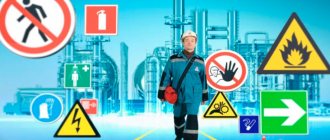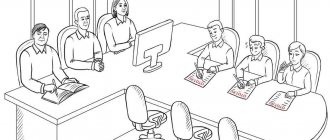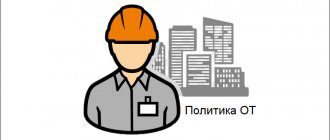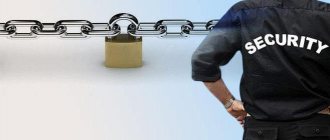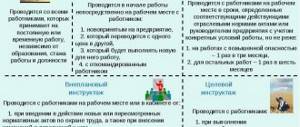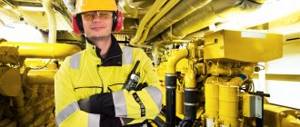Why is it necessary to monitor working conditions in the workplace?
Control at the workplace is an important component of the labor protection management system in the organization and is carried out with the aim of preventing accidents at work.
Control at workplaces is aimed at:
- identifying compliance of conditions at workplaces with regulatory legal acts on labor protection;
- identification of potentially dangerous and harmful production factors in the workplace;
- compliance by all employees of the organization with labor protection requirements;
- compliance by those responsible for labor protection with their official duties;
- detection of labor protection violations and deviations from legal requirements;
- identifying and taking effective measures to eliminate violations of working conditions in the workplace.
Thus, the employer can independently determine:
- persons responsible for monitoring working conditions in the workplace;
- levels of control (workplace, department, organization);
- types of control - targeted inspections at workplaces, unscheduled inspections, scheduled inspections, etc.;
- frequency of monitoring (daily, weekly, monthly, quarterly);
- Forms of documents for monitoring and recording violations and inconsistencies.
What types of checks are there?
Labor safety inspections can be scheduled or unscheduled (Article 360 of the Labor Code of the Russian Federation). Scheduled inspections have a set frequency. For each calendar year, a plan is drawn up with a list of organizations to be inspected and the timing of the inspection. It is posted on the website of the State Labor Inspectorate (GIT), and is also duplicated on the website of the Prosecutor General's Office of the Russian Federation.
Additionally, the company is warned about the imminent visit of auditors and upcoming verification tests 3 days before their start. The corresponding notification can be sent by mail, fax, email, delivered by courier, etc.
During a scheduled audit, the auditor is not prohibited from using a list of so-called control questions that may cover all or part of the labor protection requirements. This depends on the goals and objectives of a particular inspection and is reflected in the order to conduct it.
From March 2021, the frequency of scheduled inspections of a company depends on the risk category assigned to its activities . Thus, enterprises whose activities are classified as high risk are inspected once every two years, those with a significant risk - once every three years, etc. If the risk is assessed as low, scheduled inspections are not carried out at such a company at all.
Unscheduled inspections are initiated on the appropriate grounds (Article 360 of the Labor Code of the Russian Federation), when:
- There is an order from the head of the labor inspectorate, based on instructions from government agencies or the request of the prosecutor's office.
- The deadline for eliminating violations found earlier has passed.
- Information has emerged that the company is violating legal norms (employees are not being paid, there is a threat of harm to the health of workers at production, an accident has occurred, etc.).
- An employee complained that the employer was violating his labor rights.
- The employee asks the labor inspectorate to check the workplace.
Who exercises control?
The organization must, by order of the manager, appoint persons responsible for control at the workplace.
Form of the Order on 3-stage control
As a rule, monitoring the state of labor protection at workplaces is carried out by:
- managers and specialists assigned with relevant functional responsibilities;
- occupational safety specialist/occupational safety service;
- labor protection commission;
- Occupational Safety and Health Commissioner from the workforce.
There are currently no requirements for the education or qualifications of the person responsible for control in the legislation.
Who will check us
Each control structure has its own terms of reference. For example, by studying how employers comply with labor safety rules, the labor inspectorate
Maybe:
- visit freely at any time of the day organizations of all organizational and legal forms and forms of ownership, employers - individuals;
- request from employers and their representatives and receive from them the necessary documents, explanations, and information free of charge;
- remove samples of used or processed materials and substances for analysis;
- investigate industrial accidents;
- present orders to employers and their representatives to eliminate violations of labor legislation;
- submit to the courts demands for the liquidation of enterprises or termination of the activities of their structural divisions;
- issue orders to remove from work employees who have not completed training in safe methods and techniques for performing work, instructions on labor protection, on-the-job training and testing of knowledge of labor protection requirements;
- prohibit the use of personal and collective protective equipment for workers if such means do not comply with mandatory technical requirements and labor protection requirements; draw up protocols and consider cases of administrative offenses.
Rostechnadzor is given the right to check whether the requirements are met:
- nuclear, radiation, technical and fire safety (at nuclear energy facilities);
- industrial safety in the design, construction, operation, conservation and liquidation of hazardous production facilities, manufacturing, installation, adjustment, maintenance and repair of technical devices that are used at hazardous production facilities, transportation of hazardous substances at hazardous production facilities;
- safety in the electric power industry;
- safe conduct of work related to the use of subsoil;
- fire safety at underground facilities and during blasting operations;
- owners of hydraulic structures and operating organizations of the norms and regulations for the safety of hydraulic structures (with the exception of navigable hydraulic structures, as well as hydraulic structures, the powers to supervise which have been transferred to local governments);
- technical regulations in the established field of activity.
Rospotrebnadzor has the right to check how the requirements of legislation in the field of sanitary and epidemiological welfare of the population, as well as technical regulations, are met.
The prosecutor oversees the implementation of laws, including labor protection laws. He can:
- by presenting an official ID, freely enter the territories and premises of inspected organizations and enterprises, have access to their documents and materials, check the implementation of laws in connection with information received about violations;
- require managers and other officials to submit the necessary documents, materials, statistical and other information;
- demand that inspections be carried out on materials and citizens’ appeals received by the prosecutor’s office;
- call officials and citizens for explanations regarding violations of laws;
- make representations demanding that violations be eliminated;
- initiate an administrative case;
- go to court to protect the rights of workers or to force them to comply with the law;
- demand an inspection by other regulatory agencies, which are obliged to comply with the requirement immediately.
Despite the vague wording of the law, in reality the prosecutor's office has the greatest powers. However, it does not replace other control structures.
Trade union labor inspectors
– these are authorized (trusted) persons for labor protection of trade unions. They also have the power to monitor how employers comply with labor laws. However, the scope of their broad powers is limited by the ability to inspect only those employers who employ members of a given trade union (Article 370 of the Labor Code of the Russian Federation).
Main types of control of working conditions in the workplace
The main types of control in the workplace include:
- administrative and public control;
- departmental control;
- state control;
- public control.
Let us consider the features of each type of control of working conditions in the workplace in more detail.
Administrative and public control
Administrative and public control of working conditions in the workplace is of two types:
- 2-stage control;
- 3-speed (in some cases 4 or 5).
| stage | Who conducts it? | Frequency | What is being checked | results |
| 1st | Direct work supervisor | Every day before the start of the shift and during the shift | — state of workplaces; — serviceability of equipment, tools and devices; — operation of ventilation units; — condition of sanitary facilities; — availability of instructions and posters on labor protection; — availability and serviceability of personal protective equipment. | If violations are detected, measures are taken to eliminate them and an entry is made in the log. |
| 2nd | Head of a structural unit with a representative of the labor protection committee (commission), labor protection specialists | At least once a month, in accordance with the inspection schedule | — implementation of measures to eliminate deficiencies identified during the first stage of control; — serviceability and compliance of production and auxiliary premises, equipment, transport and lifting equipment with the requirements of safe operation; — timeliness of surveys and tests of protective equipment, equipment, lifting machines, vessels; — implementation of schedules for preventive inspections, repairs, etc.; — implementation of measures based on the results of certification of workplaces, etc.; | Detected deficiencies are eliminated and an entry is made in the journal. |
| 3rd | Occupational Safety and Health Commission | At least once a quarter | — implementation of measures to eliminate deficiencies identified during the II stage of control; — implementation of planned measures to improve working conditions and labor protection, including the measures of the “Occupational Safety and Health” section of the collective agreement, measures to respond to acts of accidents, as well as the implementation of orders, instructions, instructions on labor protection, regulations, control and supervisory authorities and recommendations committee (commission) on labor protection; — organizing training on labor protection for managers and specialists of the organization; — organization of medical examinations and other treatment and preventive measures. | The results of the examination (check) are documented in the appropriate act |
Basic reporting documents on multi-stage control
The results of the 1st and 2nd stages of monitoring the state and conditions of labor protection are recorded in journals of the established form.
Log form for the 1st level of control Log form for the 2nd level of control
The results of checking the state of working conditions at the 3rd stage of control are documented in a corresponding act. Let's consider the main design features of this document.
Main sections of the act:
- Comments and violations identified during the inspection. This section describes the identified violations with references to regulations governing this issue.
- Recommendations for eliminating violations. This section prescribes specific measures that must be taken by the contractor to eliminate violations.
- Deadline for eliminating violations.
- Responsible for eliminating violations.
- Evaluation of inspection results. In this section, the commission gives a general assessment of the results of the inspection, as well as the work of the manager on ensuring safe conditions in the workplace.
Rules for drawing up the act:
- the act is signed by all members of the commission that conducted the inspection;
- the act must be approved by the head of the organization;
- the act must indicate the date of its approval and assign a number;
- all responsible and interested persons must be familiarized with the act (under signature);
- Photo and video recording materials based on the results of the inspection can be attached to the act.
Form of the 3rd stage of control act
Attention! For large production organizations related to the operation of equipment, transport, tools, etc. It is recommended to carry out 3 or 4 stage control. For small and medium-sized enterprises (up to 200 people), 2-stage control is applicable.
Departmental control
Departmental control of the state of labor protection in the workplace is carried out by a higher organization.
This type of control is carried out during comprehensive inspections of subordinate organizations, during targeted inspections of the state of labor protection, as well as upon statements from employees of subordinate organizations.
State control
State control of the state and conditions of labor protection is carried out by:
- Federal Labor Inspectorate;
- federal executive authorities (Rostechnadzor, Rospotrebnadzor, etc.).
Supervision over the implementation of laws in force on the territory of the Russian Federation is carried out by the Prosecutor's Office of the Russian Federation.
Public control
According to Art. 370 of the Labor Code of the Russian Federation, trade unions have the right to monitor the employer’s compliance with the requirements of labor legislation.
To exercise control, the trade union at the meeting elects a labor protection representative from the workforce.
This person carries out regular inspections of working conditions at workplaces. Based on the results of the inspection, the authorized person draws up a Representation of the authorized person for labor protection - a document that indicates the identified violations and proposals for their elimination.
Occupational Safety and Health Commissioner Representation Form
The employer must eliminate the violations within a week and inform the trade union about the measures taken.
The Occupational Safety and Health Commissioner is usually a member of the Occupational Safety and Health Commission.
Preparation of documents for three-stage labor protection control
If you take a closer look at labor protection from a different angle, it becomes clear that each direction is recorded with approximately the same set of documents, as is the three-stage method of labor protection control.
In order to organize it without a hitch, you need to develop a package of documents:
- Regulations on three-stage control over labor protection.
- Order on conducting three-stage control in the organization (on the creation of a commission).
- Checking act.
- Journal of three-stage labor protection control
There are not many documents, there is no required form, but a rough understanding is necessary, so it is worth going into more detail on each of them.
Regulations on three-stage control
The regulation reveals in detail the entire sequence of conducting an audit in a particular organization, establishes the structure, and assigns the duties and responsibilities of each level. It is worth providing information on the main measures and control parameters.
As a rule, responsibility for developing regulations falls on the shoulders of a labor protection specialist; production workers who know the work of their department well can be involved as experts. If there is a trade union, then coordination with this body is required, because the rights of workers must be taken into account.
The regulation on three-stage labor protection control is approved by the head of the organization, and you can click on the link for a sample.
Order on three-stage labor protection control
The next main document is an order on three-stage labor protection control, which can be free-form. The main thing is that it reflects the composition of the commission (committee), which checks at 3 levels of control.
The composition can include diverse employees, not necessarily only management, it can vary from director to blue-collar professions. In this case, the inspection will be carried out more efficiently, because an employee who is constantly at work can know and notice some shortcomings that reduce safety and bring them to the attention of the entire commission.
The chairman, of course, should be the employer or his deputy, it can also be the chief engineer, it all depends on the hierarchy of your organization. The ideal option is when the members of the commission include employees who:
- competent in labor safety issues;
- have extensive work experience in this organization;
- interested in conducting full control.
The composition of the commission (committee) for conducting three-stage control should be odd, it could be 3 people, or you might want to include 7 employees. I leave you an order to conduct a three-stage control, which you can download by following the link.
Journal of three-stage labor protection control
The next stage of analysis and preparation of documents is a log of three-stage labor protection control, which is necessary to record violations at stages 1 and 2; for stage 3 in some organizations the results are also documented in a log, and in others only in an act, but more on that later .
The frequency of filling out the journal determines the position that you have developed, and in addition to the shortcomings, you need to record the activities that need to be carried out by the person in charge.
A separate journal is kept for each division and its form can be determined individually. You can download a sample log of three-stage labor protection control by clicking on the link.
If, based on the regulation, only self-control is allowed at the 1st level of control, then if violations are detected, the employee must report the detected shortcomings to his immediate supervisor.
Act of three-stage control on labor protection
The act of three-stage control on labor protection prepares the 3rd stage of control. This form can be developed by you yourself, but, in fact, it may look like an order from an occupational safety specialist.
The act must summarize and record all identified violations in a specific area, determine the measures that must be taken to eliminate them, assign responsible persons and deadlines for implementation. I leave a three-stage labor protection control act, a sample of which you can find here.
Additional types of monitoring of labor protection status and conditions
The organization can also separately organize inspections of the condition and working conditions by a labor protection specialist.
An occupational safety specialist can carry out both targeted (scheduled) and unscheduled inspections.
Targeted inspections are carried out in accordance with the approved schedule.
Form of schedule for inspections of labor conditions and labor protection
The results of inspections are formalized in the form of an order indicating the identified violations and inconsistencies, the deadlines for elimination and the appointment of persons responsible for eliminating the identified violations.
Unscheduled inspections are carried out outside the schedule of targeted inspections. Unscheduled inspections, as a rule, are carried out in connection with various types of accidents, as well as industrial accidents. The results of unscheduled inspections are documented in the relevant acts.
Form of act-prescription for targeted/unscheduled inspection of working conditions
Inspection rules
Inspections of compliance with the Labor Code of the Russian Federation, ratified conventions of the International Labor Organization and other regulations on labor protection are carried out on the basis of the above-mentioned Regulations and the Federal Law “On the protection of the rights of legal entities and individual entrepreneurs in the exercise of state control (supervision) and municipal control” of December 26, 2008. No. 294-FZ.
Nuances that you need to know about when checking by OT:
- the basis for the inspection is the order (instruction) of the head of the State Inspectorate;
- the inspection period cannot be more than 20 working days (for small enterprises - 50 hours, for micro-enterprises - 15 hours), but in special conditions (when conducting complex research and examinations) it can be extended by the same period;
- an authorized representative of the employer must be present during the inspection;
- During the inspection, the inspector must be given unimpeded access to the territory, premises of the enterprise, equipment and requested documentation within the scope of the inspection.
Based on the results of the inspection, a report on the identified violations is drawn up with references to regulatory requirements. The act is drawn up in two or more copies and signed by a representative of each party participating in the inspection: the employer, State Tax Inspectorate and other supervisory authorities. Each party receives its own copy of the act. Based on it, an order is drawn up to eliminate the identified violations, indicating the deadlines. It is possible to submit a motion to the court to suspend activities for up to 90 days.
Procedure and timing of control at workplaces
The procedure and frequency of monitoring at workplaces is established by the employer.
The organization must develop and approve by the employer a Regulation on the organization of monitoring the state of working conditions and a schedule of inspections. The document can be found at the link >> Regulations on the organization of stepwise monitoring of the state of labor protection conditions in the organization.
Form of a schedule for monitoring the state and conditions of labor protection
Monitoring the state of working conditions in the workplace gives the manager an objective picture of the state of labor protection in the organization. This information is a source for forming an effective action plan to improve working conditions at the enterprise.
Form of an action plan to improve working conditions at the enterprise Get advice on labor protection
Appealing the result
If the head of the organization being inspected or the person representing him does not agree with the conclusions of the commission, he can appeal its results by filing an application with the court or a higher official of the State Tax Inspectorate. To invalidate a result, it is necessary to prove that the law was violated during its implementation. Usually the reason for this is that the labor safety inspectorate did not provide an administrative document or during the control the conditions specified in it were not observed - deadlines, subject, etc. There are also procedural violations when the State Labor Inspectorate official prepared the necessary documents.
This means that it is necessary to prepare appropriate claims and complaints. Experts will help. Appealing the regulations of the State Tax Inspectorate is one of the areas of our work. Since there is no form for filing a complaint, this may be difficult. Our experienced lawyers will draw up the document in such a way that it is guaranteed to be reviewed by the head of the labor safety inspectorate. If everything is done correctly, the chances are high that the Chief State Inspector or the court will recognize the applicant as correct and the order as unlawful. It will no longer be valid and you will not have to pay a large fine. Support from a specialized company will help save financial and time resources and increase the likelihood of the issue being resolved in your favor.

